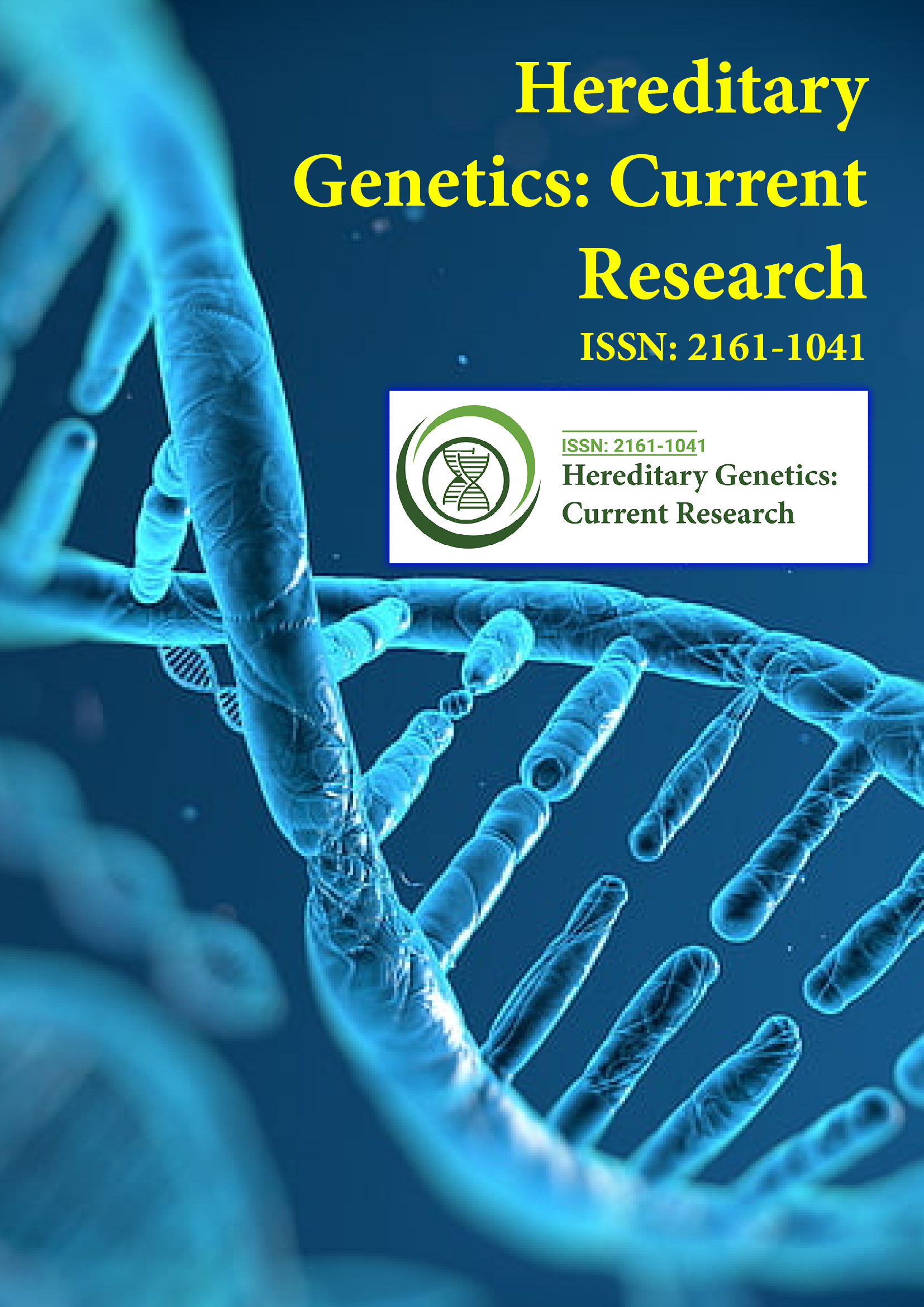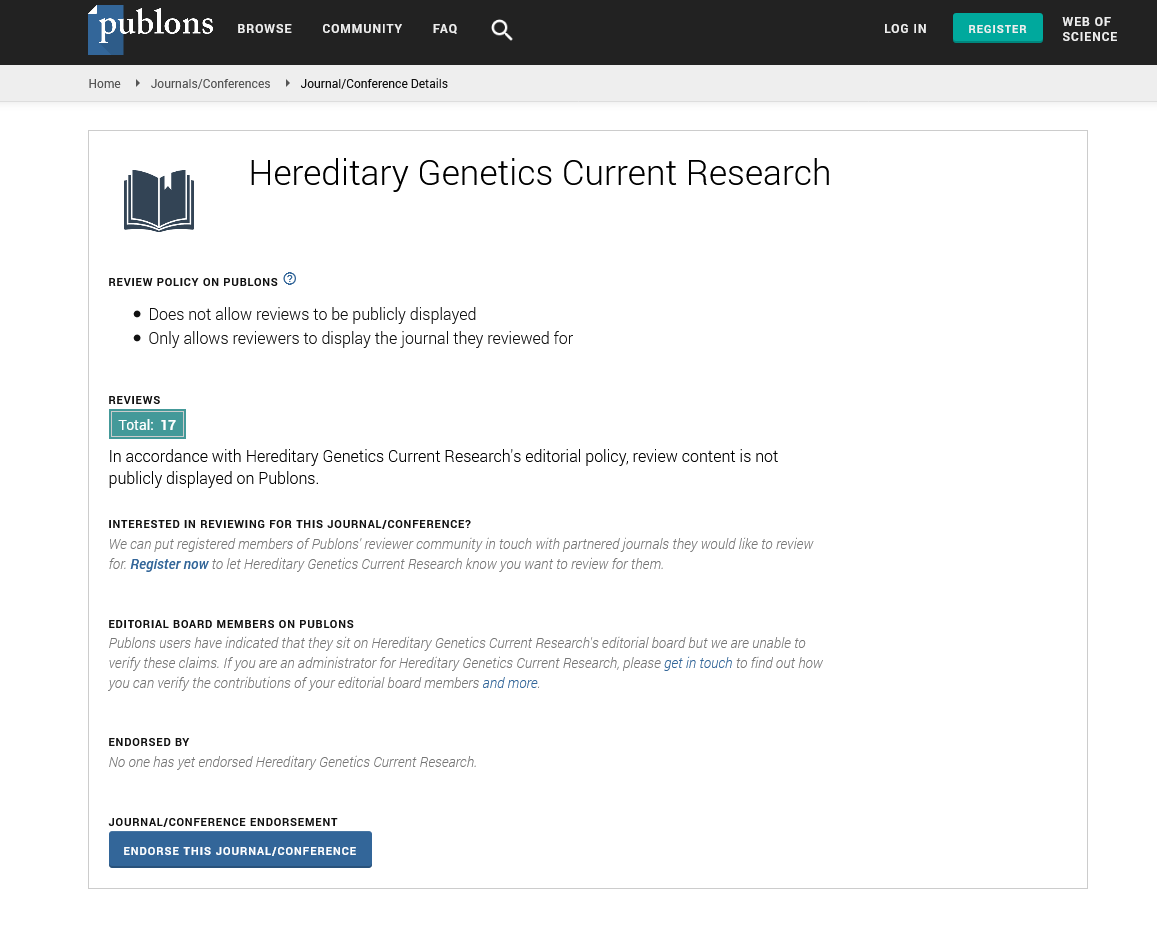PMC/PubMed Indexed Articles
Indexed In
- Open J Gate
- Genamics JournalSeek
- CiteFactor
- RefSeek
- Hamdard University
- EBSCO A-Z
- NSD - Norwegian Centre for Research Data
- OCLC- WorldCat
- Publons
- Geneva Foundation for Medical Education and Research
- Euro Pub
- Google Scholar
Useful Links
Share This Page
Journal Flyer

Open Access Journals
- Agri and Aquaculture
- Biochemistry
- Bioinformatics & Systems Biology
- Business & Management
- Chemistry
- Clinical Sciences
- Engineering
- Food & Nutrition
- General Science
- Genetics & Molecular Biology
- Immunology & Microbiology
- Medical Sciences
- Neuroscience & Psychology
- Nursing & Health Care
- Pharmaceutical Sciences
Perspective - (2023) Volume 12, Issue 1
Atopic Dermatitis a Genetic Skin Disorder: Disease Management and Therapeutic Approaches
Liu Zechen*Received: 06-Mar-2023, Manuscript No. HGCR-23-19963; Editor assigned: 09-Mar-2023, Pre QC No. HGCR-23-19963 (PQ); Reviewed: 23-Mar-2023, QC No. HGCR-23-19963; Revised: 30-Mar-2023, Manuscript No. HGCR-23-19963 (R); Published: 06-Apr-2023, DOI: 10.35248/2161-1041.23.12.236
Description
Disease management and therapeutic approaches
Consistent treatment guidelines are not advised for Atopic Dermatitis (AD) management because of the disease's individual clinical variability. In order for patients to be fully productive at home, work, and school, the goals of therapy include lowering pruritus and establishing durable disease control. Hence, a multistep approach is required, with interventions aimed at avoiding important triggers, enhancing the skin barrier, reversing skin dysbiosis, and decreasing inflammation. Treatment is generally chosen based on the severity of the condition, with adjustments made for the patient's age, the existence of comorbidities linked to and unrelated to atopy, treatment response, compliance issues, and cost. For the best results, treatment should be combined with a formal patient and carer treatment education programme. Superinfection and microbial colonization could exacerbate existing conditions and necessitate further care. Aeroallergen-specific immunotherapy may be taken into consideration in certain circumstances. Counseling for psychosomatic issues is advised in cases of stress-related exacerbations. Most suggested treatments for inflammation and skin barrier disruption also address pruritus, however certain individuals may require additional treatment (e.g., cannabinoid receptor agonists, opioid receptor antagonists, memolizumab). Identification of specific trigger variables is crucial to the management of AD, and their avoidance permits longer periods of remission or complete symptom elimination. The AD skin can become irritated by a variety of environmental factors, including mechanical irritants (such as wool, irritating fabrics and fibres), chemical irritants (such as acids, bleaches, solvents, and surfactants in cosmetic and hygiene products), biological irritants (such as allergens and microbes), and air pollutants like tobacco smoke, volatile organic compounds, and traffic exhaust.
The foundation of treatment for people with mild-to-moderate AD is topical hydration and lubrication, combined with suitable cleansing/bathing techniques. Basic therapy also focuses on correcting disrupted barrier function. Moisturizers with non- aqueous emollients, occlusive agents, and humectants enhance barrier function, lessen the signs and symptoms of AD, and lessen the requirement for topical corticosteroids when applied regularly. Topical anti-inflammatory therapy based on corticosteroids and calcineurin inhibitors is recommended for both proactive long-term control and managing flare-ups. In individuals with established disease, Topical Corticosteroids (TCSs) continue to be the first line treatment, reducing disease recurrence when taken irregularly. The location, extent, and acute or chronic nature of skin lesions, patients' age, and disease severity should all be taken into consideration while choosing a steroid. TCSs are divided into classes based on their anti-inflammatory potency. For mild illness, flexural and facial skin lesions, young children, and pregnant women, low-potency TCSs are recommended. For older individuals, lichenified and persistent prurigo-like sores, and palms, high potency TCSs are preferred. In areas of sensitive skin, such as the face and flexural skin, Topical Calcineurin Inhibitors (TCIs), tacrolimus and pimecrolimus, are preferable. These medications are authorised for short-term and chronic intermittent use in children and adults aged 2 and older. TCIs may also have activities to restore the epidermal barrier while inhibiting cutaneous T cell activation and proliferation.
Reduced efficacy, burning or pruritus that is frequently experienced during the first week of usage and expense all serve to restrict their utilisation. For people with mild-to-moderate AD or in anatomically sensitive regions, topical phosphodiesterase inhibitors such crisaborole, a novel anti-inflammatory class that inhibits the intracellular enzyme cAMP-specific 3,5-cyclic Phosphodiesterase 4 (PDE4), may be an additional alternative. Short-term phototherapy should be taken into consideration as an adjuvant if disease management with topical treatments is not possible. The most efficient kind of UV radiation is narrow-band ultraviolet B (NB-UVB/UVB 311 nm) and medium-dose ultraviolet A1 (UVA1) light. Systemic therapy is advised when topical therapies and phototherapy fail, become unsatisfactory, or become unworkable. The non-specific immunosuppressants cyclosporine, azathioprine, methotrexate, and mycophenolate mofetil are systemic non-biologic treatments that are well- established and readily accessible for severe refractory cases. The most successful treatment for AD was cyclosporine, the only systemic medication licenced for short-term use but its usage is restricted by potential side effects, including nephrotoxicity. Even in youngsters, azathioprine and methotrexate are safe and efficient off-label therapies for severe AD.
Mycophenolate mofetil, which is also used off-label for AD, has a better safety profile but a more constrained efficacy. It is regarded as a maintenance therapy or third line alternative after disease control with another more potent systemic drug. Mycophenolate mofetil and azathioprine had relatively similar medication survival profiles, according to studies, although mycophenolate mofetil was terminated primarily due to inefficiency whereas azathioprine was primarily due to side effects. While being approved for the treatment of AD, systemic corticosteroids should only be used as a last resort to control acute flares or as a stopgap measure before switching to another systemic, steroid-free medication, according to published treatment guidelines. Dupilumab, a completely human monoclonal antibody against IL-4R that inhibits both IL-4 and IL-13 signalling, targets the Th2 pathway and may be a secure and efficient alternative for treating disease.
Particularly when paired with TCSs, it demonstrated considerable improvements in disease severity and boosted the proportion of patients who responded. One of the most common diseases in the world, AD has a significant negative influence on patients and carers quality of life as well as health care resources. Moreover, AD has crucial implications for managing and treating its many medical and mental health comorbidities. A significant need for better disease prevention emerges given the mounting evidence that AD may develop into other allergy phenotypes. Even though enormous progress has been made in the field of AD research, more knowledge about the illness is still needed.
Citation: Zechen L (2023) Atopic Dermatitis a Genetic Skin Disorder: Disease management and Therapeutic Approaches. Hereditary Genet. 12:236.
Copyright: ©2023 Zechen L. This is an open-access article distributed under the terms of the Creative Commons Attribution License, which permits unrestricted use, distribution, and reproduction in any medium, provided the original author and source are credited.

